Madlener House
4 West Burton Place
Chicago, Illinois 60610
Telephone: 312.787.4071
[email protected]
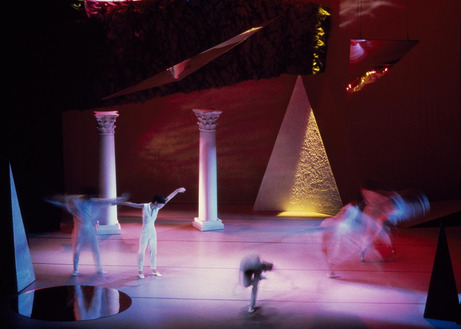
To conclude our current exhibition, Barbara Kasten: Stages, please join us for a conversation between Barbara Kasten and Chicago-based artist Chelsea Culprit. The discussion will be accompanied by a special screening of Inside Outside / Stages of Light (1985), Kasten’s collaborative performance with noted choreographer and dancer Margaret Jenkins, which marked a critical moment in the artist’s interests in theatricality, the prop, and architectural scale.
Barbara Kasten received her BFA from the University of Arizona, Tucson, in 1959 and her MFA from the California College of Arts and Crafts, Oakland, in 1970. She has had solo exhibitions at institutions such as the George Eastman House, International Museum of Photography and Film, Rochester; the San Francisco Museum of Modern Art; and the International Center of Photography, New York, among others. Her work is in numerous museum collections, including the Museum of Modern Art, New York; the Whitney Museum of American Art, New York; the Museum of Contemporary Art, Chicago; and the Los Angeles County Museum of Art.
Chelsea Culprit is a Chicago-based artist and curator whose practice spans multiple disciplines. Her recent solo projects include Cloud Illusions I Recall at Born Nude, Chicago and ella, ella, ella... at Johannes Vogt Gallery, NY, among others. Culprit has performed at The Museum of Contemporary Art, Chicago; The New Museum; and The Rijksmuseum, Amsterdam. She is Co-Director with artist Ben Foch of New Capital, a Chicago-based exhibition space and curatorial project. Culprit graduated from The School of the Art Institute of Chicago with a dual degree in Studio Art, Art History Theory and Criticism.
Image: Inside Outside/Stages of Light, 1985. Still from the video documentation of a performance at the Brooklyn Academy of Music. Courtesy of the artist and Margaret Jenkins. Collection of the BAM Hamm Archives, Brooklyn Academy of Music.
Please note: Seating is first-come, first-served and RSVP does not guarantee entry, so please plan to arrive early.
For more information on the exhibition, Barbara Kasten: Stages, click here.
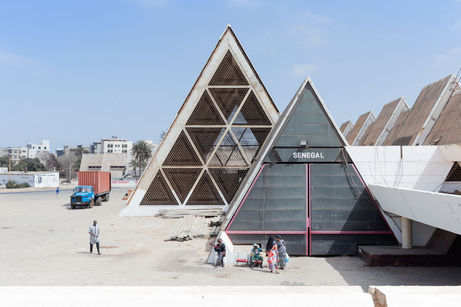
Please join us for a reception and talk by curator and author Manuel Herz to celebrate the opening of our winter exhibition, Architecture of Independence: African Modernism.
Friday, January 29
6:00pm: Talk by curator and author Manuel Herz
7-8:30 pm: Opening Reception
This exhibition is based on the book project African Modernism: Architecture of Independence by Manuel Herz in cooperation with the Vitra Design Museum in Weil am Rhein, Germany.
Manuel Herz is an architect based in Basel, Switzerland. His recent projects include the Synagogue and Jewish Community Center in Mainz, Germany. He has taught at the ETH Zürich and at Harvard’s Graduate School of Design, and is currently professor of architecture and urban design studies at the University of Basel. Manuel's research addresses the relationship between migration, architecture, and nation-building and the spaces of refugee camps. His publications include Nairobi: Migration Shaping the City (with Shadi Rahbaran and supported by a Graham Foundation grant; Lars Müller Publishers, 2014); From Camp to City: Refugee Camps of the Western Sahara (Lars Müller Publishers, 2013); and African Modernism: Architecture of Independence.
Image: Jean Francois Lamoureux and Jean-Louis Marin, FIDAK - Foire Internationale de Dakar, 1974, Dakar (Senegal). Photo © Iwan Baan.
For more information on the exhibition, Architecture of Independence: African Modernism, click here.

The Graham Foundation in partnership with Lampo is pleased to present Roc Jiménez de Cisneros, one half of the Barcelona-based sound-art duo EVOL. De Cisneros will premiere Opus17aSlimeVariation#8—an interpretation of German conceptual artist Hanne Darboven’s legendary Opus 17a, newly arranged for computer and RGB laser.
EVOL’s approach to Darboven's original score focuses mainly on time manipulation. Hanne Darboven worked with processes that manipulated numbers and patterns. She often used calendar dates organized according to new rules and visually displayed these grids on paper. Her Opus 17a is derived from one such calendar-based artwork (Wunschkonzert, 1984), in which numbers are transcribed into musical notes. In both a tribute to the original, and an experiment in temporal distortion, EVOL transforms Darboven's grid into a new sonic experience.
Opus17aSlimeVariations is part of a series that began in 2014 and has been presented live and as an installation, using different sound materials each time. The project was first developed in collaboration with programmer Guy Birkin.
Roc Jiménez de Cisneros (b.1975, Barcelona) is an artist, composer and co-founder of the computer music project EVOL, which he started with Stephen Sharp in 1996. His work is a radical and playful exploration of algorithmic composition. Heavily influenced and inspired by cosmology, noise and rave culture, he describes his recordings, installations and performances as “computer music for hooligans.” His output has been released on labels such as Entr’acte, Presto!?, Mego, Fals.ch and ALKU, which he runs with Anna Ramos. He has performed extensively throughout the world. He lives and works in Barcelona.
This performance is presented in partnership with Lampo. Founded in 1997, Lampo is a non-profit organization for experimental music, sound art and intermedia projects. For information and to add your name to the Lampo list, visit http://www.lampo.org.
PLEASE NOTE: Seating for this performance is extremely limited. RSVP is required and event entry is first-come, first-serve, so please plan to arrive early. Doors will open at 7:30pm.
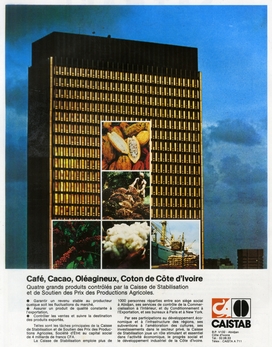
The five countries—Ghana, Cote d’Ivoire, Kenya, Senegal and Zambia—whose modern architectural productions are featured in Architecture of Independence, present the opportunity to examine where the collective and the individual fit in the post colonial era. In his lecture architecture historian Nnamdi Elleh will connect the sociopolitical conditions of the newly independent countries with the modernist buildings erected post-independence. Elleh will address several key questions: Why did these countries fall into different states of violence following the fall of the Berlin Wall, the end of the Cold War, an era that has been seen as the rise of neoliberal economy in the world and in Africa in general? This lecture will draw from the exhibition to explore the challenges facing these countries and different parts of the continent today.
Nnamdi Elleh is associate professor of architecture, history and theory at DAAP, University of Cincinnati. He was trained as an architect and received his PhD in art history from Northwestern University. He was a Fulbright Teaching-Research Scholar at the University of Cape Town, where he studied post-apartheid nationalist inspired architecture in South Africa. His research focuses on modern and contemporary architecture as diverse, multi-centered, regional and localized experiences in different parts of the world. Elleh’s selected books include African Architecture, Evolution and Transformation (McGraw Hill, 1996); Architecture and Power in Africa (Praeger, 2001); and Reading the Architecture of the Underprivileged Classes: A Perspective on the Protests and Upheavals in Our Cities (Ashgate, 2014).
image: Photomontage of Bernard Nivert and Robert Boy’s Building for the Fund for Stabilization and Support of Agricultural Produce Prices (CAISTAB), 1970, Abidjan, Côte d'Ivoire, featuring the country’s primary agricultural produce. Originally published in the national magazine Fraternité Matin, November 1981.
For more information on the exhibition, Architecture of Independence: African Modernism, click here.
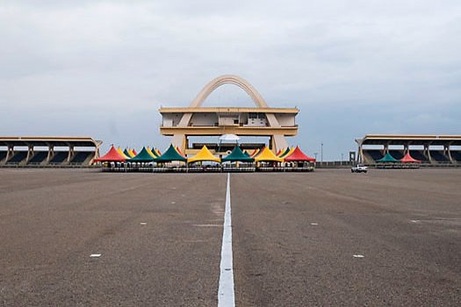
In 2008, Mabel Wilson and Peter Tolkin traveled through Ghana, documenting the architecture that had been erected during the 1950's and 1960's in the decades following the end of European colonial rule.These mid-century buildings were mostly modernist, designed by architects from Australia, the United Kingdom, the United States, Lebanon, Italy and Ghana; they had been reviewed in contemporary architectural publications, as part of a lively debate on what became known as “tropical modernism.” Until recently, the legacy of these mid-century buildings had all but disappeared from the western historical canon; and with their absence we've failed to understand how critical the African continent was to the discourse of modernism. In this talk, Wilson and Tolkin will discuss their project, examining how these buildings have fared in the half-century since their construction and how they function in today's increasingly urban and global contexts.
Mabel O. Wilson is an award-winning designer and scholar. She received a doctorate in American Studies from NYU and an MArch from Columbia’s Graduate School of Architecture, Planning and Preservation. As the Nancy and George E. Rupp Professor at Columbia University's GSAPP, she directs the program for Advanced Architectural Research, co-directs the Global Africa Lab, and is a Senior Fellow at the Institute for Research in African American Studies in GSAS. Her collaborative design practices (KW: a and Studio &) have worked on speculative and built projects. Wilson's scholarly research investigates space and cultural memory in black America, race and visual culture, and new technologies and the social production of space. Her essays have appeared in numerous journals and books on critical geography, cultural memory, visual culture, and architecture. Wilson's recent book, Negro Building – Black Americans and the World of Fairs and Museums, studies how the spaces of world’s fairs, emancipation expositions, and grassroots public museums became sites to imagine Afro-modernity.
Peter Tolkin is the founding principal of Peter Tolkin Architecture. Influenced by his formal education with renowned American artists Allan Sekula and Lewis Baltz and subsequent work as a documentary photographer, his practice speaks to the social and cultural context of a project. With a natural curiosity in the contingencies that impact the conditions of contemporary culture, Tolkin’s seminal explorations as an artist provided the conceptual kernel for an architectural practice that interprets contextual narratives. He received a BA in Art and Art History from the University of California, Santa Cruz, a MFA in Photography from the California Institute of the Arts, and a MArch from Columbia University. Tolkin continues to practice photography as a complement to his architectural work.
Image: Black Star Square, also know as Independence Square, was built to commemorate independence from colonial rule. Accra, Ghana, 1961.
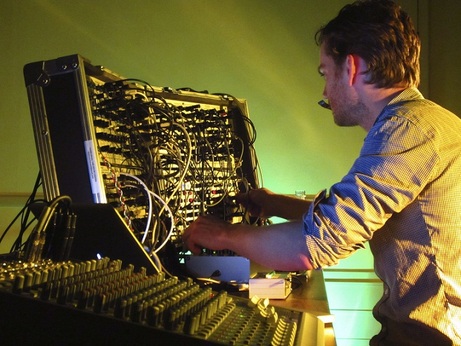
Dutch artist Thomas Ankersmit will premiere new work commissioned by Lampo—a composition for analog Serge modular and digital oscillators that combines a blizzard of microsounds with sculptural fields of pure tone. This project is Ankersmit's first significant foray into the digital realm and first fully quadraphonic composition.
Thomas Ankersmit is a composer, musician and installation artist based in Berlin and Amsterdam. Acoustic phenomena such as sound reflections, infrasonic vibration, otoacoustic emissions, and highly directional projections of sound have been an important part of his work since the early 2000s. His music is also characterized by a deliberate misuse of equipment, using feedback and disruptions to the signal, and the extremes of frequency and dynamics, to create visceral but finely detailed swarms of sound. Since 2006 his main instrument, both live and in the studio, has been the Serge analogue modular synthesizer. His recent collaborations include a series of electroacoustic pieces with Sicilian composer and performer Valerio Tricoli; recording sessions with Kevin Drumm at GRM in Paris; and a new Phill Niblock composition for Serge modular synthesizer (Niblock’s first piece for an electronic instrument). Ankersmit has performed twice before in the Lampo series—in February 2012 and September 2008.
Commissioned by Lampo with the support of the Performing Arts Fund NL. This performance is presented in partnership with Lampo. Founded in 1997, Lampo is a non-profit organization for experimental music and intermedia projects.
Please Note: Seating for this performance is very limited. RSVP is required and event entry is first-come, first-serve, so please plan to arrive early. Doors will open at 7:30pm.

Join us on Thursday, March 17 for a special screening of the short film, Afronauts, with director Frances Bodomo and film scholar Jacqueline Stewart. Based on true events, Afronauts tells the story of the short-lived Zambian space program and its attempts to join the space race in the late 1960s. Afronauts is Bodomo's second short film and premiered at Sundance Film Festival in 2014. (Total runtime: 14 minutes)
Frances Bodomo is an award-winning Ghanaian filmmaker who grew up in Ghana, Norway, California, and Hong Kong before moving to New York City to study film at Columbia University (BA) and the Tisch School of the Arts (MFA). Her first short film, Boneshaker (starring Oscar-nominee Quvenzhané Wallis), premiered at the 2013 Sundance Film Festival and played at over 20 film festivals. Bodomo was named a 2015 Sundance Institute/Alfred P. Sloan Fellow and aspires to make conceptually strong films that bring African images to the forefront.
Jacqueline Stewart is a professor in the Department of Cinema and Media Studies at the University of Chicago. She is the author of Migrating to the Movies: Cinema and Black Urban Modernity (University of California Press, 2005). Her essays have appeared in Critical Inquiry, Film Quarterly, Film History, and The Moving Image. She is completing a study of African American actor, writer, and director Spencer Williams. She is co-curator of the L.A. Rebellion project at the UCLA Film and Television Archive. Her film work in Chicago includes founding the South Side Home Movie Project and serving as Curator of Black Cinema House, a neighborhood-based film exhibition venue run by Theaster Gates’ Rebuild Foundation.
This event is presented in conjunction with the Graham Foundation's current exhibition Architecture of Independence: African Modernism, on view through April 16.
To view the trailer for Afronauts, click here.
Image: Diandra Forrest as Matha. Afronauts. Dir Frances Bodomo, 2014.
For more information on the exhibition, Architecture of Independence: African Modernism, click here.

In 2004, architect, academic, and novelist Lesley Lokko made the decision to build her own house in Accra, Ghana, where she grew up. In an era where middle-class Ghanaian aspirations tend firmly towards neo-Classicism, Lokko’s “Miesian mud house” provoked much criticism. ‘Is it a petrol station?’, one passer-by asked indignantly, referring to the white, square Shell petrol stations, first introduced in Accra in the early 1960s, few of which are still standing in their original state. In conjunction with the Graham Foundation’s new exhibition, Architecture of Independence: African Modernism, Lokko will explore the relationship between form, memory, identity, and independence.
Lesley Lokko is head of the Postgraduate School of Architecture at the University of Johannesburg and the author of nine best-selling novels. She received her BSc(Arch) and MArch from the Bartlett School of Architecture, University College London, and her PhD in architecture from the University of London. She has taught at schools of architecture in the US, the UK, as well as South Africa, where she was Visiting African Scholar at the University of Cape Town. She is the editor of "White Papers, Black Marks: Race, Culture, Architecture" (University of Minnesota Press, 2000) and has been an on-going contributor to discourses around identity, ‘race’, African urbanism and the speculative nature of African architectural space for almost twenty years.
Image: House Lokko. Completed July 2005, Accra, Ghana. Photo by Lesley Lokko.
For more information on the exhibition, Architecture of Independence: African Modernism, click here.
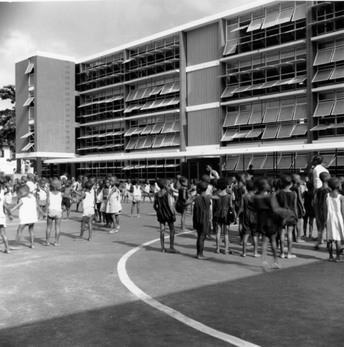
The creation of an African education curriculum and improved access to education have been central to the continent’s development goals from the dying days of colonization to the present. During Africa’s early independence era of the 1950’s and ‘60s, a significant number of school building projects were commissioned to respond to this need. This period of architectural production in Anglophone West Africa coincided with the constellation of a final tranche of colonial funds, international aid, and the presence of a cadre of young modernist architects, many of whom were affiliated with the Architectural Association’s Tropical School. Ola Uduku will explore the architecture, historic symbolism, and legacy of some of the most significant schools built during period and the architects and other actors who contributed to their design.
Ola Uduku is reader in architecture and Dean International for Africa at Edinburgh University’s School of Architecture and Landscape Architecture (ESALA). She received her PhD from the University of Cambridge, was Smutts Fellow in African Studies, and has lectured at Liverpool and Strathclyde Universities. Her research interests include: the history of educational architecture in Africa, gated communities, and issues surrounding social infrastructure provisions for minority communities in cities. In 2014 she completed the British Academy-funded Alan Vaughan Richards Archive Project. Currently she is involved in the Conserving West African Modernism Project (with KNUST, Kumasi) and is founding member of ArchiAfrika, a non-profit dedicated to improving architectural education and knowledge of architectural history in Africa. She is also a member of Docomomo International and is supporting Ghana’s membership application. Her publications include chapters and articles in Architecture Beyond Europe (2015); Radical Pedagogies Project (2015); and Designing Schools: Space, Place and Pedagogy in the Twentieth Century (Taylor and Francis, forthcoming), among others.
Image: Fry and Drew, CMS Primary School Lagos, c.1950s. From the exhibition AA in Africa, Architectural Association School of Architecture, London, 2002.
For more information on the exhibition, Architecture of Independence: African Modernism, click here.
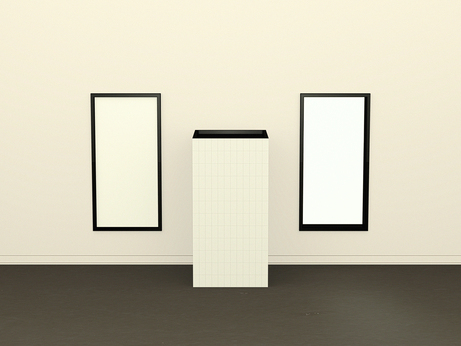
In 1965, Joseph Kosuth first exhibited One and Three Chairs, an artwork comprised of a manufactured chair, a photograph of the chair, and a typed definition of a chair all placed in proximity within a gallery. Soon, other triads followed, including One and Three Shovels, One and Three Plants, and One and Three Photographs. As the interchangeability of the readymade objects he selected attests to, Kosuth was less concerned with the aesthetic value of the art he displayed than with the questions it raised. What, for example, is the relationship between the three items presented- an object, a depiction, and a description? Or, alternatively, between an idea, an instance, and an image?
Sarah Blankenbaker, the 2015–16 Douglas A. Garofalo Fellow at the UIC School of Architecture, will discuss her culminating fellowship exhibition, One and Three. Like Kosuth’s series, from which the exhibition borrows its name, One and Three presents sets of three versions of the same thing—a photograph, a façade, and a window—as an exploration of the translation of images into architecture and vice versa.
Sarah Blankenbaker is a clinical assistant professor at the UIC School of Architecture and the 2015-16 Douglas A. Garofalo Fellow. She first moved to Chicago as an undergraduate, earning a BA in mathematics and visual art from the University of Chicago. While photographing buildings and spaces across the city, she was drawn to the architecture she encountered and subsequently departed for Los Angeles to study at the Southern California Institute of Architecture (SCI-Arc). Blankenbaker has worked for Terreform in New York and Zago Architecture in Los Angeles. While at Zago Architecture, she was part of a team that participated in Foreclosed: Rehousing the American Dream at MoMA in New York. In 2011, she returned to Chicago to join the faculty at the UIC School of Architecture, where she has been teaching design studios, technology seminars, and YArch, a summer program for people who, like herself, discover architecture while pursuing other interests. Her work has been shown as drawings in Chicago and Los Angeles and appeared as writing in Log, Future Anterior, and Time + Architecture.
About the Douglas A. Garofalo Fellowship
Named in honor of architect and educator Doug Garofalo (1958–2011), this nine-month teaching fellowship, supported with a grant from the Graham Foundation, provides emerging designers the opportunity to teach studio and seminar courses in the undergraduate and graduate programs and conduct independent design research. The fellowship also includes a public lecture at the Graham Foundation and an exhibition at the UIC School of Architecture in the spring. To learn more about the fellowship, click here.
Image: Sarah Blankenbaker, A photograph, a façade, a window, 2016. Courtesy of the artist.
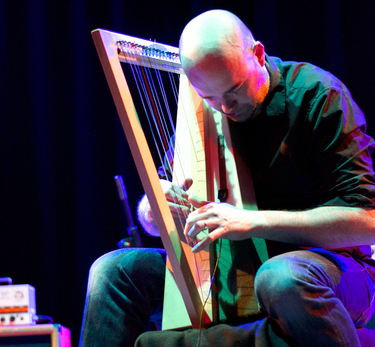
Welshman Rhodri Davies confronts traditional concepts of the harp through his use of preparations, de-tuned, bowed and e-bowed strings.
On April 9, in his Chicago solo debut and first local appearance since 2002, Davies will present recent works for both lap harp and concert pedal harp.
Rhodri Davies plays harp, electric harp, live-electronics and builds wind, water, ice and fire harp installations. He has released four solo albums—Trem (2001), Over Shadows (2007),Wound Response (2012) and An Air Swept Clean of All Distance (2014). His regular groups include a duo with John Butcher, Common Objects, HEN OGLEDD: Dawson – Davies, a trio with David Toop and Lee Patterson, Cranc, The Sealed Knot and a trio with John Tilbury and Michael Duch. In 2008 he collaborated with the visual artist Gustav Metzger on Self-cancellation, a large-scale audio-visual collaboration in London and Glasgow. New pieces for solo harp have been composed for him by Eliane Radigue, Phill Niblock, Christian Wolff, Ben Patterson, Alison Knowles, Mieko Shiomi and Yasunao Tone. In 2012 he was the recipient of the Foundation for Contemporary Arts, Grants to Artists Award.
Please Note: Seating for this performance is very limited. RSVP is required and event entry is first-come, first-serve, so please plan to arrive early. Doors will open at 7:30pm.

Angelo Plessas is an artist based in Athens. The focus of his work is to network the offline with the online in ways that make us understand aspects of both conditions, and to generate new ways of relating to both. His activities range widely—from performances to artist residencies; from self-publishing to interactive websites; from sculptures, to live-stream events and different educational projects. For the last four years, he has organized annual, weeklong gatherings of The Eternal Internet Brother/Sisterhood.
The Graham Foundation is pleased to present this talk in partnership with the Department of Art Theory and Practice at Northwestern University.
This lecture is made possible by support from the Myers Foundations and the Jerrold Loebl Fund for the arts.
Image: Eternal Internet Brother/Sisterhood 1-3, Angelo Plessas, 2015, Courtesy the Breeder, Athens.

Please join us for a talk on May 5 by Beatriz Colomina, Graham grantee and curator of the exhibition, Playboy Architecture, 1953–1979, opening at the Elmhurst Art Museum on May 7.
Sex, architecture and design were inextricably intertwined in the pages of Playboy magazine from the very beginning. Architecture was not simply featured in the magazine but was its very mechanism. The sexual fantasies and the architectural fantasies were inseparable. Architecture turned out to be more seductive than the playmates. It became the ultimate playmate.
With its massive global circulation and sexualization of architecture, Playboy arguably had more influence on the dissemination of modern design than professional magazines, interiors magazines, and even institutions like the Museum of Modern Art.
Playboy architecture is all about the interior. The Playboy is an indoors man. The magazine was relentlessly obsessed with the interior and this interior turns out to be infinite. From the furniture to the clothes, the lighting, the music, the food, the drinks, the conversation, the jokes, the ideas, the art, the architecture, the smells, and even the way to move, to act… everything is provided. The magazine created a total work of art. When you open the pages of the magazine you are invited to dive in into this world without gaps, without cracks, without decay… an infinite perfected interior, a total work of art.
Beatriz Colomina is professor of architecture and founding director of the program in Media and Modernity at Princeton University. She has written extensively on questions of architecture, art, sexuality and media. Her books include Manifesto Architecture: The Ghost of Mies (Sternberg, 2014); Clip/Stamp/Fold: The Radical Architecture of Little Magazines 196X-197X (Actar, 2010); Domesticity at War (MIT Press, 2007); Privacy and Publicity: Modern Architecture as Mass Media (MIT Press, 1994); and Sexuality and Space (Princeton Architectural Press, 1992). Colomina has curated a series of exhibitions in Venice, Kassel, London, Frankfurt, Barcelona, Santiago de Chile, Bogota, Vancouver, Oslo, Lisbon, New York, Murcia, Montreal, Warsaw, Rotterdam, Maastricht and Vienna. She will co-curate, with Mark Wigley, the 2016 Istanbul Design Biennial. She was born in Madrid, studied architecture and completed her Ph.D. in Barcelona and lives in New York City.
This lecture is presented in partnership with the Elmhurst Art Museum.
Image:"The Playboy's Town House," Playboy, May 1962. Architect: R. Donald Jayce. Rendering by Humen Tan.

Please join us for a talk by curator and writer Candice Hopkins on Saturday, May 7.
Candice Hopkins is based in Albuquerque, New Mexico. She has held curatorial positions at the IAIA Museum of Contemporary Native Arts, National Gallery of Canada, the Western Front and the Walter Phillips Gallery at the Banff Centre. Her writings on history, art, and vernacular architecture have been published by MIT Press, BlackDog Publishing, Revolver Press, New York University, the Fillip Review and the National Museum of the American Indian, among others. Hopkins has lectured widely including at the Witte de With, Tate Modern, Dakar Biennale, Tate Britain and the University of British Columbia. Hopkins was co-curator of the 2014 SITE Santa Fe biennial exhibition, "Unsettled Landscapes." In 2014 she received the Joan Lowndes award from the Canada Council for the Arts for excellence in critical and curatorial writing. She currently is a curatorial advisor for Documenta 14, opening in 2017.
The Graham Foundation is pleased to present this talk in partnership with the Department of Art Theory and Practice at Northwestern University.
This lecture is made possible by support from the Myers Foundations and the Jerrold Loebl Fund for the arts.
Image: Beau Dick, Tsonokwa Mask, 2007 Red cedar, horse hair and acrylic, 78.8 × 66.1 × 35.6 cm.Photo: National Gallery of Canada.
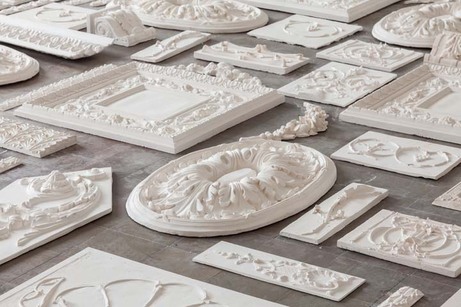
Please join us for a reception and artist talk by Michael Rakowitz to celebrate the opening of our new exhibition, The Flesh Is Yours, The Bones Are Ours.
Wednesday, May 18
6-7pm: Talk by Michael Rakowitz
7-8:30pm: Opening Reception
Michael Rakowitz is an artist living and working in Chicago. He received his BFA in sculpture from Purchase College, SUNY, and his MS in visual studies from MIT. His work has appeared in venues worldwide, including dOCUMENTA 13, PS1, MoMA, MassMOCA, Castello di Rivoli, the 16th Sydney Biennale, the 10th Istanbul Biennial, Sharjah Biennial 8, the Tirana Biennale, the National Design Triennial at the Cooper-Hewitt, and Transmediale 05. Solo exhibitions include the Tate Modern in London, Lombard Freid Gallery in New York, Trafo Gallery in Budapest, and Kunstraum Innsbruck. Rakowitz is the recipient of a 2012 Tiffany Foundation Award; a 2008 Creative Capital Grant; a Sharjah Biennial Jury Award; a 2006 NYFA Fellowship Grant in Architecture and Environmental Structures; the 2003 Dena Foundation Award; and the 2002 Design 21 Grand Prix from UNESCO. His work features in major private and public collections, including the Museum of Modern Art, New York; Neue Galerie, Kassel, Germany; the Smart Museum of Art, Chicago; the Van Abbemuseum, Eindhoven, the Netherlands; the British Museum; the Kabul National Museum, Afghanistan; and UNESCO, Paris. Rakowitz is professor of art theory and practice at Northwestern University.
Image: Michael Rakowitz, "The Flesh Is Yours, The Bones Are Ours," 2015. Installation view, Galata Greek Primary School, 14th Istanbul Biennial. Photo by Sahir Ugur Eren.
For more information on the exhibition, The Flesh Is Yours, The Bones Are Ours, click here.
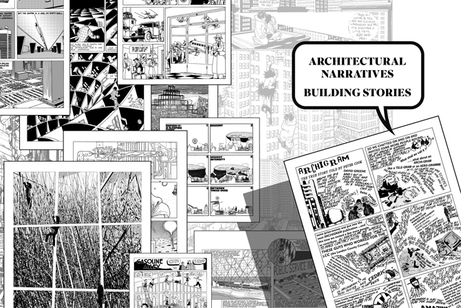
Koldo Lus Arana will discuss his recent research on the interactions between comics and architecture—both from a historical perspective and exploring current overlaps. Arana will explore the work of contemporary architects such as Jimenez Lai, Willem Jan Neutelings and many others who use comics and cartoons within their work, to the presence of architecture in comics such as those created by Chris Ware or François Schuiten.
Koldo Lus Arana is an architect, illustrator and architecture scholar. He earned a Master in Design Studies from Harvard GSD in 2008, and a PhD from the University of Navarra in 2013 with the dissertation Futuropolis: Comics and the Transmediatic Construction of the City of the Future. His main lines of research deal with the interactions between architecture and media, and with architectural prospective. He currently teaches Theory and History of Architecture in the University of Zaragoza (Spain).
This lecture is presented in partnership with MAS Context. MAS Context is a quarterly journal that addresses issues that affect the urban context.
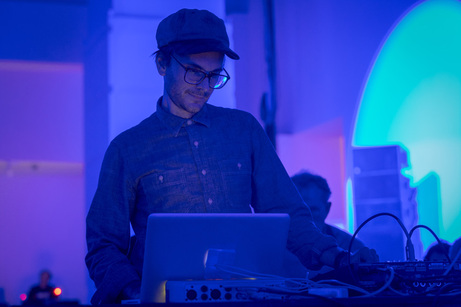
Reducing the Tempo to Zero is Ben Vida’s new, four-hour composition for four vocalists and electronics. Taking its cues from works like Stockhausen’s Sternklang, Morton Feldman’s String Quartet No. 2, and La Monte Young and Marian Zazeela’s Dream House, RtTtZ directly intervenes within the space of the gallery to oscillate between installation and performance. By employing long-form elements, Vida manipulates the listener’s experience of temporality, stripping the work of basic structural signifiers (such as a strict beginning, middle, and end), which results in an arrangement that reconsiders how the developmental arc of a musical composition might function. Prompting its audience to reinterpret their own agency (both by encouraging them to experience the piece from a number of different locations and allowing them to determine their own length of engagement with the work), RtTtZ summons multiple tempos, melodies, textures, and rhythms into a string of spatial moments, challenging a listener’s expectation, context, and perspective, while actively setting up a different kind of experiential proposal.
Given the length of this performance, audience members are invited to come and go throughout the duration of the event.
Ben Vida is an artist and composer living in New York. He has been an active member of the international experimental music community for two decades, with a long list of collaborators, projects and releases to his credit. In the mid-1990s, he cofounded the group Town and Country, and has since worked as a solo artist with labels such as PAN, Alku, Shelter Press, Future Audio Graphics, and Kranky. Vida has been the recipient of several awards, including an ISSUE Project Room Artist-in-Residency Commission; a Museu d’Art Contemporani de Barcelona Composing with Process Exclusive Works Commission; the Unsound Festival’s New Works Commission; and a Swedish Arts Committee travel grant. His recent residencies include EMS Studios, Stockholm; EMPAC, Troy, NY; and the Clocktower, NYC. His work has been performed and presented at the Guggenheim, New York; the Museum of Contemporary Art, Chicago; the Institute of Contemporary Art, London; the Kitchen, New York; Leap Gallery, Berlin; 356 Mission Road, Los Angeles; the Artist’s Institute, New York; the Sydney Opera House; Museo d’Arte Moderna di Bologna; the Borderline Festival, Athens, Greece; and the Royal Festival Hall, as part of the Meltdown Festival, in London. Vida will have his first solo exhibition at Lisa Cooley Gallery, NYC, in Spring 2016.
This performance is presented in partnership with Lampo. Founded in 1997, Lampo is a non-profit organization for experimental music and intermedia projects.

Aki Nagasaka, Project T, T for Taut, 2010
Taking its inspiration from Michael Rakowitz’s engagement with the work of an Armenian artisan and his Turkish pupil in the exhibition The Flesh Is Yours, The Bones Are Ours, this talk traces the intertwined stories of similar translations across time, space, and medium that end in Istanbul: the work of Armenian photographer Abdullah Frères during the Ottoman Period; the built environs of Turkish and German architects Sedad Eldem and Bruno Taut during the Early Republic; and the output of British and Japanese contemporary artists Victor Burgin and Aki Nagasaka. All the exhibitions, including the one on view at the Graham Foundation and the others that materialize in the lecture, perform unordinary acts of architectural history and preservation, bearing witness to the power of transversal dialogues against the absences created by historical violence.
Esra Akcan is associate professor in the Department of Architecture at Cornell University. She completed her architecture degree at the Middle East Technical University in Turkey, and her PhD and postdoctoral degrees at Columbia University. She has taught history-theory classes and architectural design studios at the University of Illinois at Chicago, Humboldt University (Berlin), Columbia University, the New School, Pratt Institute, and METU (Ankara, Turkey). Her awards and fellowships include those from the American Academy in Berlin, the University of Illinois at Chicago, the Institute for Advanced Studies in Berlin, the Graham Foundation, the Clark Institute, the Getty Research Institute, the Canadian Center for Architecture, the College Art Association, the Mellon Foundation, DAAD and KRESS/ARIT. Akcan is the author of the Architecture in Translation (Duke University Press, 2012), Turkey: Modern Architectures in History (Reaktion, 2012, with Sibel Bozdoğan), Çeviride Modern Olan (YKY, 2009), and (Land)Fill Istanbul: Twelve Scenarios for a Global City (124/3, 2004). She has guest-edited issues for Domus m (on globalization) and Centropa (on German-Turkish history), and coedited an issue for Nakhara (on writing Asian modernity). Her more than one-hundred published articles include writings on contemporary theory (critical and postcolonial theory, globalization); modern and contemporary architecture in West Asia; Ottoman architectural photography; established Euro-American architects’ engagement with the Gulf States; and the Middle Eastern diaspora in Europe.
Akcan’s scholarly work engages a geopolitically conscious global history of architecture, where her research on modern and contemporary architecture and urbanism foregrounds the intertwined histories of Europe and West Asia. Her book Architecture in Translation: Germany, Turkey and the Modern House offers a new way to understand the global movement of architecture that extends translation beyond language to visual fields. Advocating a commitment to a new culture of translatability from below and in multiple directions, it aspires toward cosmopolitan ethics and global justice. Her coauthored book Turkey: Modern Architectures in History contributes to a series that aims to produce an inclusive survey of modern world architecture, and is the first volume in any language to cover the entire twentieth century in Turkey. She is currently working on her next book on the urban renewal of Berlin's immigrant neighborhood, through which she explores a theory of open architecture.
Image: Aki Nagasaka, Project T, T for Taut, 2010.
For more information on the exhibition, The Flesh Is Yours, The Bones Are Ours, click here.
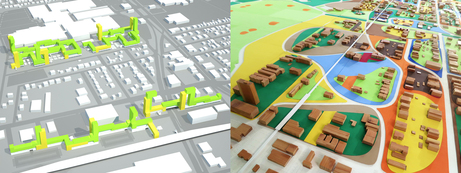
References to American suburbia typically conjure distinct images of vast, homogenous tracts of post-war residential neighborhoods, filled with white, middle-class families who left the city in search of the “American Dream” of the single-family house and lawn. Yet decentralization is neither new, nor monolithic, nor specifically American; rather, it is evident as early as the third millennium BCE outside the typical Mesopotamian city, where outlying settlement was often focused on commerce and industry. Early American suburbia was likewise often industrial, and developed as distinct municipalities, some of which were annexed by their central cities, others of which faded into oblivion, and still others of which developed into thriving economic hubs. Simultaneously, decentralization acted back upon the traditional city center, forcing a reconsideration of its own forms and qualities.
The contemporary American metropolis is therefore characterized by a wide range of decentralized urbanisms, many of which exhibit formal and spatial patterns that are much more open than in traditional settlement-what Lewis Mumford called “spatial looseness.” Because these patterns are harder to identify, understand, and instrumentalize, and because the architecture is so often banal, these conditions are easily dismissed. There is significant value in understanding them, however, as they not only are the largest and fastest growing parts of the metropolis, but also are evolving extremely quickly. They are, therefore, the primary sites of potentially innovative new architectures and new urbanisms.
This roundtable thus asks: what are the new forms of architecture and urbanism of decentralization in the American metropolis? What are the primary forces being materialized in their making (new and evolving collectives, democratic processes, free markets, new forms of mobility, others)? And what are the opportunities for the future?
Marshall Brown is a licensed architect and principal of Marshall Brown Projects. He is also an Associate Professor at the IIT College of Architecture. He is a Graham Foundation grant awardee, is currently exhibiting in the U.S. Pavilion for the 2016 Venice Architecture Biennale, and participated as a finalist in the 2012 Navy Pier Centennial Vision competition. He has new projects on view in Chicago during spring and summer 2016 at both the Arts Club of Chicago and Western Exhibitions gallery. Marshall Brown’s work has been exhibited at the Museum of Contemporary Art Detroit and Western Exhibitions in Chicago. He has served on the editorial board of the Journal of Architectural Education and has lectured at the Chicago Humanities Festival, University of Michigan, Northwestern University, the Graham Foundation, and the Arts Club of Chicago. His projects and essays have appeared in several books and journals, including Metropolis, Crain’s, Architectural Record, The New York Daily News, Art Papers, The Believer, and New Directions in Sustainable Design.
Robert Bruegmann is an historian and critic of the built environment. He received his PhD in art history from the University of Pennsylvania in 1976 and since 1979 has been at the University of Illinois at Chicago where he is currently Distinguished Professor Emeritus of Art History, Architecture and Urban Planning. Among his books are The Architects and the City: Holabird & Roche of Chicago 1880-1918 published in 1998, Sprawl: A Compact History, 2005 and The Architecture of Harry Weese, 2010. He is currently acting as editor of a book tentatively titled Art Deco Chicago about Chicago architecture, industrial design, graphic design and fashion c. 1910-50. His main areas of research are in the history of architecture, urban planning, landscape and historic preservation.
Architect Claire Cahan is Design Director at Studio Gang, an architecture and urbanism collective based in Chicago and New York. Engaging projects of various scales and typologies, Studio Gang uses design as a medium to connect people socially, experientially, and intellectually. The Studio’s research-based approach is coupled with a focus on sustainability to produce built projects that engage with pressing social, political, and ecological issues, such as the recently completed Arcus Center for Social Justice Leadership at Kalamazoo College, as well as design proposals for new typologies including Polis Station, which works with community partners to reorient police stations toward the neighborhoods they serve. Claire has led and collaborated on many of the Studio’s most pivotal projects, from the Northerly Island framework plan to a proposal for Cicero, Illinois. Developed as part of Museum of Modern Art’s 2012 exhibition Foreclosed: Rehousing the American Dream, the proposal transforms the inner-ring suburb into a thriving live-work community. A Chicago native, Claire holds a Master of Architecture from Tulane University in New Orleans. Living and learning in different urban contexts informs her understanding of the challenges facing cities today and reinforces her belief in the essential relationship between built and natural environments.
Judith K. De Jong is an architect, urbanist, and Associate Professor of Architecture at the University of Illinois at Chicago, whose work investigates the reciprocating relationships between architecture and the city, and the opportunities for design innovation in architectures and urbanisms of mass culture. Her book, New SubUrbanisms, was published in 2013. De Jong has received support from the Graham Foundation and the Great Cities Institute, where she was a 2011-2012 Faculty Scholar, and has presented her work in the U.S., Mexico City, Hong Kong, and Israel. She has written for MONU, Land Forum, CITE: The Architecture and Design Review of Houston, and The Journal of Architectural Education, among others, and her proposal “How the Strip Mall Can Save Suburbia” was a finalist in the 2010 Build A Better Burb competition. De Jong received a Master of Architecture in Urban Design from Harvard University, and a Bachelor of Architecture from the Pennsylvania State University.
Andrew Metter is currently Principal Design Consultant at Epstein in Chicago. He holds a Master of Architecture from Washington University in St. Louis. His work has received numerous design awards including Chicago Chapter AIA Distinguished Building Honor Awards. He has been the recipient of Design Awards from Progressive Architecture magazine, as well as the Architectural League of New York. His architectural works have been published in Progressive Architecture, Architecture, Architectural Record, Architect, and 150 Years of Chicago Architecture. His work has been exhibited at the Art Institute of Chicago, Museum of Science and Industry Chicago, Institute d’Architecture Francais, Paris; and the Gulbenkian Museum, Lisbon. He is an adjunct professor at IIT, and recently served as Co-Chair of the Board of Overseers of The College of Architecture at IIT. In conjunction with his IIT studio, Metter has pursued the study of leveraging existing infrastructure network systems to address the re-distribution of food, social services, and manufacturing in the City of Chicago. He is also past Chair of the Gold Medal Committee of the National AIA Committee on Design. His Serta project, which has been published widely, has received a number of national and international awards, including being named “Best of 2009” by Blair Kamin of the Chicago Tribune, and a 2010 National AIA Honor Award.
Juan Gabriel Moreno, AIA, is an award winning architect and President/Founder of JGMA (Juan Gabriel Moreno Architects). Mr. Moreno was born in Bogota, Colombia and studied architecture at California State Polytechnic University Pomona. He also lived in Florence, Italy where he studied under Superstudio founders Christiano Toraldo di Francia and Gianni Pettena. Mr. Moreno has been creating provocative works for more than 30 years. His portfolio includes having worked on projects throughout the United States and internationally. These projects represent a diverse portfolio of public and private work in typologies ranging from education, government, research, commercial, urban planning, product design and graphic design. However, in 2010 he launched JGMA with the sole purpose of transforming Chicago’s diverse communities with his architecture. Since then, JGMA has become one of the most highly acclaimed design firms in Chicago. In 2015 was recognized by Architect Magazine as one of the Top 50 Design Firms in the United States. Additionally, JGMA’s work was on display at the inaugural Chicago Architectural Biennial and Juan was invited to several of the Biennial’s panels to share his work and vision with the design community.
Mark Muenzer is the Director of Community Development for the City of Evanston. Evanston, the home of Northwestern University, is a densely populated urban suburb immediately north of Chicago along Lake Michigan. Evanston contains a vibrant and rapidly expanding downtown as well as many traditional multi-family and single-family neighborhoods adjacent to local business districts and numerous CTA and Metra transit stations. Muenzer heads a department of 35 staff members in four different department divisions – Building & Inspection Services, Planning & Zoning, Housing & Grants Administration and Transportation & Mobility. Prior to his tenure with Evanston, he was with the City of Chicago Dept of Planning & Development and managed the City’s Plan Commission and Zoning Board of Appeals and also served as the Community Development Director for the City of Countryside. He holds Bachelors in Political Science from Gannon University (PA) and a Masters in Community Planning from the University of Cincinnati. He resides in Chicago’s Ravenswood neighborhood.
Image: “How the Strip Mall Can Save Suburbia” by Judith K. De Jong and “Smooth Growth” by Marshall Brown
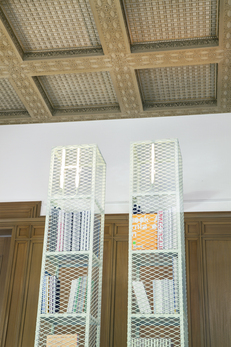
View of the Graham Foundation bookshop designed by Ania Jaworska, Chicago, 2013. Photo Travis Roozée.
Please join the Graham Foundation for its inaugural Bookshop Summer Sale beginning August 6th, 2016 with a day of refreshments, music, and special discounts. The sale will run through August 13th, 2016 ending on the final day of our current exhibition, The Flesh Is Yours, The Bones Are Ours. Don't miss the unprecedented deals or your last chance to view the work of Michael Rakowitz installed in the Madlener House galleries—select titles up to 50% off.
The Graham Foundation Bookshop offers a selection of publications produced by the Foundation's grantees and titles related to our public programming, as well as new, historically significant, and rare publications on architecture, urbanism, art, and related fields. The bookshop carries monographs, exhibition catalogues, research, and theory-based titles from a range of publishers such as Sternberg Press, Lars Müller, Soberscove, Primary Information, Hatje Cantz, Architectural Association Publishers, Columbia GSAPP, MIT Press, Princeton Architectural, San Rocco, MAS Context, and many more.
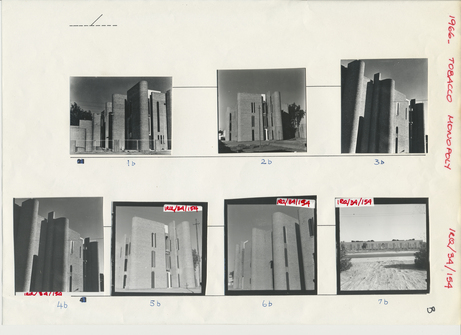
Rifat Chadirji, IRQ/314/154: Offices and stores, Tobacco Monopoly Administration, Baghdad, 1966. Photographic paste-ups, 8.27” × 11.69”. Courtesy of the Arab Image Foundation.
Please join us for a reception and talk by curator Mark Waisuta to celebrate the opening of our new exhibition, Every Building in Baghdad: The Rifat Chadirji Archives at the Arab Image Foundation.
Thursday, September 15
6pm: Talk by Mark Wasiuta
6:30-8pm: Opening Reception
Mark Wasiuta is a curator, writer, and architect who teaches at GSAPP, Columbia University where he is Co-Director of the MS degree program Critical, Curatorial, and Conceptual Practices in Architecture. Over the last decade, as Director of Exhibitions at GSAPP, he has developed a body of research and archival exhibitions that focus on underexamined practices of the postwar period. Recent exhibitions, produced with various collaborators, include, Control Syntax Rio at Het Nieuwe Instituut, Environmental Communications: Contact High at the Chicago Architecture Biennial La Fine Del Mondo, at the 14th International Architecture Exhibition at the Venice Biennale, as well as Information Fall-Out: Buckminster Fuller’s World Game, and Les Levine: Bio-Tech Rehearsals 1967–1973 at the Arthur Ross Architecture Gallery. He is co-editor and co-author of Dan Graham’s New Jersey. Forthcoming projects include the exhibitions, Detox USA, at the 3rd Istanbul Design Biennial and the publications, Documentary Remains, Environmental Communications: Contact High, and Collecting Architecture Territories. He is partner in the design and research office the International House of Architecture.
The Graham would like to thank Perrier for supporting our public programs.
For more information on the exhibition, Every Building in Baghdad: The Rifat Chadirji Archives at the Arab Image Foundation, click here.
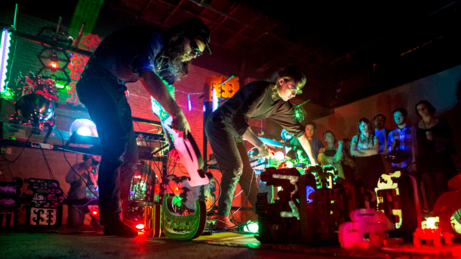
The art duo MSHR premieres Macro Synthetic Helio Resistor, a quadraphonic performance involving their new Boolean logic chip-based analog modular synthesizers in a feedback system with lasers, strobes and incandescent lights.
MSHR is the collaborative project of Birch Cooper (b.1985) and Brenna Murphy (b.1986, Edmonds, Wash.). Cooper and Murphy build and explore systems to reveal pathways toward ecstatic sensory experience. They work at the intersection of digital sculpture, analog circuitry and ceremonial performance. Their physical projects have largely revolved around analog light-audio feedback systems built from macro-arrangements of their sculptural synthesizers. On the virtual side, they weave computer generated portraits of inter-dimensional entities and psychedelic realms.
MSHR emerged from the five-person art collective Oregon Painting Society in 2011 and has since exhibited and performed at Upfor, Portland; Kunsthaus Langenthal; Postmasters Gallery, NYC; Musee des Artes Creteil; Cell Projects, London; Transmediale, Berlin; TBA, Portland; Yerba Buena Center, San Francisco; The Peckham Pavilion, 53rd Venice Biennale; Kunstverein Dusseldorf; Three Walls, Chicago; Western Front, Vancouver; American Medium, NYC; Appendix Project Space, Portland; Le Dictateur, Milan. They were 2014 artists-in-residence at Eyebeam and are currently artists in residence at Pioneer Works.
Brenna Murphy made her Chicago debut in September 2012, when she presented a new live performance entitled SkyFace~TextureMappr and a collection of video works for Lampo and Conversations at the Edge.
This performance is presented in partnership with Lampo. Founded in 1997, Lampo is a non-profit organization for experimental music and intermedia projects.
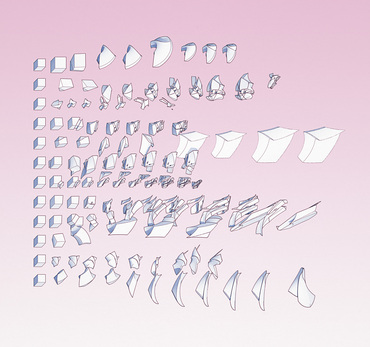
The Graham Foundation Bookshop is pleased to host the release of the fourth issue of Prescriptions, a quarterly zine edited by Ann Lui and Craig Reshke of Chicago-based architecture office Future Firm. The latest issue features a conversation with design technology specialist Andrew Heumann, focusing on the role of computation in professional and aesthetic practices.
To celebrate the release, join us for a reception and a discussion in the bookshop between Future Firm and Heumann. Past issues of the zine will be available for purchase alongside issue four, as well as a selection of related publications.
The title, Prescriptions, suggests that architectural practice may need some corrective medication. The zine features one interview per issue with builders of all kinds on their beginnings and futures. Topics in issue four include the emergence of a "coding class," democratic access to parametric design, C-3PO, computational camps and cultures, and the intersections of algorithms with governance.
Visit rx-mag.com to learn more about Prescriptions.
As a design technology specialist at Woods Bagot, Andrew Heumann develops custom tools and workflows for design teams across the firm. Formerly the leader of NBBJ’s design computation team, he has written more than fifteen plug-ins for 3D modeling tools (“Human,” the most popular, has had more than 20,000 downloads) and created many bespoke tools for design teams and practices, aiding in the management of project metrics, environmental and urban analysis, and façade design. Outside of his professional work, Heumann is a generative artist, working with data, algorithms, geometry, and pixels to create rich visual abstractions that engage and challenge the limits and affordances of digital media. He is trained in both architecture and computer science, and has lectured and taught seminars at Cornell University, Yale University, California College of the Arts, and the University of Washington. His work has been published in Wallpaper magazine, CLOG journal, and presented at conferences including ACADIA, SIMAUD, Autodesk University, and the AEC Technology Symposium.
Ann Lui is an assistant professor of architecture/interior architecture at the School of the Art Institute of Chicago. She holds an SMArchS from MIT in history, theory, and criticism and a BArch from Cornell University, where she was awarded the Charles Goodwin Sands Medal and the Clifton Beckwith Brown Memorial Medal. Previously, she practiced at SOM, Ann Beha Architects, and Morphosis. Lui was assistant editor of OfficeUS Atlas (2015) and coeditor of Thresholds, "Scandalous" (2015).
Craig Reschke is an architect interested in landscape practices. He is a registered architect in the state of Illinois. He graduated from Harvard's Graduate School of Design, where his research focused on rural American landscapes, and he graduated with the Jacob Weidenmann Prize. He also holds a BArch from the University of Tennessee. Previously, Reschke was a project architect at SOM and RODE Architects, where he led the design of buildings at many scales.
Future Firm is a Chicago-based architecture office interested in the intersections between landscape territories and architectural spectacle. Recent research explores the relationship between finance, economy, and the built environment.

As part of our continuing collaboration with Northwestern University's Department of Art Theory and Practice, the Graham is pleased to host Joshua Simon, who will present The Kids Want Communism, a yearlong program of exhibitions marking 99 years since the October Revolution, which he initiated in collaboration with State of Concept Athens, Free/Slow University of Warsaw, Tranzit Prague, Skuc gallery in Ljubljana, the Visual Culture Research Center in Kiev, and MoBY-Museums of Bat Yam. The talk will outline how the communist horizon and real existing socialism can inform our understanding of the current social and cultural, political, and economic realities we are facing with the implosion of the neoliberal order. Simon's research in the past several years has been focused on notions of materiality and subjectivity, therefore, this talk will move between animism and productivism, commodity fetish and debt economy, double negation and metabolism, shock work and the dividual.
Joshua Simon is director and chief curator at MoBY-Museums of Bat Yam, as well as a co-founding editor of the Tel Aviv-Jaffa based Maayan publishing. He is the author of Neomaterialism (Sternberg Press, 2013), and editor of Ruti Sela: For The Record (Archive Books, 2015). Recent curatorial projects include: Factory Fetish at Westspace, Melbourne, co-curated with Liang Luscombe in 2015; Roee Rosen: Group Exhibition at the Tel Aviv Museum of Art, co-curated with Gilad Melzer in 2016; and The Kids Want Communism at MoBY in 2016. From 2011-2013, he was a Vera List Center for Art and Politics fellow.
This lecture is part of the Department of Art Theory and Practice at Northwestern University Visiting Artist Lecture Series, and is made possible with generous support from The Myers Foundations and the Jerrold Loebl Fund for the arts.
Image: El Lissitzky, Poster for the Russian Exhibition (Russische Ausstellung), Kunstgewerbemuseum Zürich, March 24- April 28, 1929.
The Graham would like to thank Perrier for supporting our public programs.
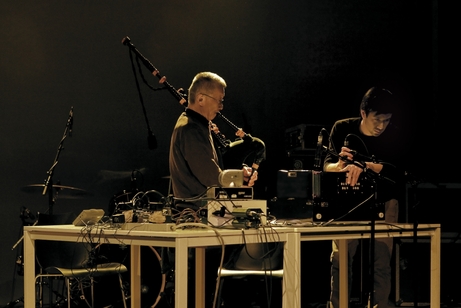
Composer, instrument builder and Fluxus artist Yoshi Wada and composer Tashi Wada make a rare Chicago appearance—Yoshi’s first since ’93 and Tashi’s local debut. The father-son duo presents an evening-length performance for Lampo based on a loose, ever-shifting structure with a newly modified setup of sirens, alarm bells, audio generators, bagpipes and organ.
Yoshi Wada (b.1943, Kyoto, Japan) is a composer and artist associated with the downtown New York experimental art scene of the last fifty years. He studied sculpture at the Kyoto University of Fine Arts, and then moved to New York in the late 1960s. Wada joined the Fluxus movement in 1968 after meeting its founder George Maciunas. In the early 1970s he began building homemade musical instruments and writing compositions for them based on his personal research in timbre, resonance and improvisation with the overtone series. He studied music composition with La Monte Young, North Indian singing with Pandit Pran Nath, and Scottish bagpipe with James McIntosh and Nancy Crutcher. Wada has presented his work at The Kitchen, New York; New Music in America, New York; Whitney Biennial, New York; Akademie der Kunste, Berlin; Emily Harvey Gallery, New York; Biennale of Sydney, Australia; Festival d’Automne, Paris; PS1, New York; Venice Biennale; and AV Festival, Newcastle, UK. His recorded works are published by Japanese record labels EM Records and Omega Point.
Tashi Wada (b.1982, New York, N.Y.) grew up in New York and lives in Los Angeles. His compositions use apparently simple structures and carefully calibrated tuning systems to generate rich and unanticipated perceptual effects. Wada presents his music often in collaboration with other artists including Charles Curtis and Stephan Mathieu, in addition to performing regularly with his father Yoshi Wada. He also runs Saltern, an imprint of Important Records, which he started in 2014.
This performance is presented in partnership with Lampo. Founded in 1997, Lampo is a non-profit organization for experimental music and intermedia projects.
The Graham would like to thank Perrier for supporting our public programs.

Sara Ludy premieres a new live audiovisual performance that arranges found imagery and field recordings into a rhythmic composition of otherworldly forms.
Ludy has worked with browsed images since 2000, generating works such as Low Prim and Postcards. More recently, she has collected pictures of natural disasters, tragedy and death, or what she calls “everyday horror.” In this special project, she alters these images until they become unrecognizable, blurring and shaping them into undulating 3D bodies and landscapes. Ludy also adds layered sound—manipulated recordings of AC hum and the buzz of traffic, trees, birds and insects captured from her workspace while browsing online. Tones rise and fall with the visual forms.
By combining materials from these dissimilar environments, and then filtering them through her inner world and intuitions, Ludy’s performance becomes an opportunity for the artist to expel the effects of image saturation through a meditative process.
Sara Ludy (b.1980, Orange, Calif.) is a Chicago-based artist whose practice investigates the confluence of the physical and virtual. Her practice incorporates photography, Second Life, animation, video, sound and live performance. Recent exhibitions include Museum of Contemporary Art Chicago, Chicago; bitforms gallery, New York; Postmasters Gallery, New York; Klaus von Nichtssagend, New York; Interstate Projects, Brooklyn; Eyebeam Center for Art and Technology, New York; Vancouver Art Gallery, Vancouver; Western Front, Vancouver; Kuenstlerhaus Bethanien, Berlin; Carroll Fletcher, London; Espace Verney-Carron, Lyon; and C-Space, Beijing.
This performance is presented in partnership with Lampo. Founded in 1997, Lampo is a non-profit organization for experimental music and intermedia projects. Support provided to Lampo by mediaThe foundation inc.
Image courtesy of Sara Ludy
The Graham would like to thank Perrier for supporting our public programs.
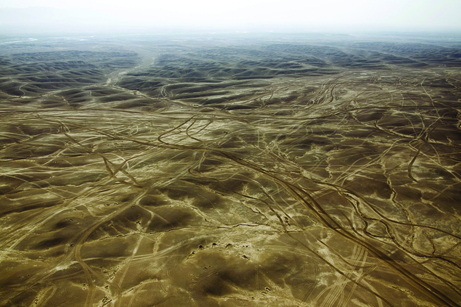
Join the Graham Foundation Bookshop for the launch of Ecologies of Power: Countermapping the Logistical Landscapes & Military Geographies of the U.S. Department of Defense (MIT Press, 2016), a Graham funded publication by Pierre Bélanger and Alexander Arroyo. Taking place as part of a new Saturday series of Graham Foundation grantee book launches in the Madlener House foyer, an informal space between the Graham Foundation’s Grantee Library and Bookshop, this event will feature a discussion between Bélanger and Arroyo as they introduce their anti-disciplinary process of research, development, and collaboration on the book during the past six years. The presentation will provide insight into the often neglected discourse about the role of media in spatial policy, logistical operations, military deployment, and infrastructural development at the intersection of matters of land, landscape, terrain, territory, and power. The talk will be followed by a reception in the bookshop where copies of the title will be available.
Weaving together an extraordinary range of visual media and original geographic work, this critical cartographic volume counter-maps the geospatial footprint of the U.S. Department of Defense beyond the battlefield, revealing a vast and shifting military-logistical landscape reshaping infrastructures and environments at every scale. Moving beyond conventional military geographies of combat zones and covert operations, Pierre Bélanger and Alexander Arroyo explore the forces and forms of this landscape from the molecular and metabolic to the political and the planetary, giving new dimension to familiar military milieux of land, air, sea, and space. In so doing, they trace out a growing assemblage of logistically linked “operational environments,” where militarized, demilitarized, and non-militarized landscapes are ever more entangled. It is in this assemblage that they find emergent ecologies of power at work in the making, unmaking, and remaking of operational environments across existing, emerging, and future horizons.
Pierre Bélanger is a landscape urbanist, founder of OPSYS (Landscape Infrastructure Lab), and Associate Professor of Landscape Architecture and Co-Director of the postgraduate Master’s Degree in Design Studies Program at Harvard University’s Graduate School of Design. Bélanger has received two Graham Foundation grants to individuals and is the national curator of the Canada Pavilion for the 2016 Venice Architecture Biennale.
Alexander Arroyo is an environmental designer and critical geographer with a background in philosophy from Columbia University and landscape architecture from Harvard University, currently pursuing his PhD in Geography at the University of California, Berkeley.
Related Graham supported projects:
Image: Helmand Valley Region (Afghanistan) © Behrouz Mehri AFP Getty.
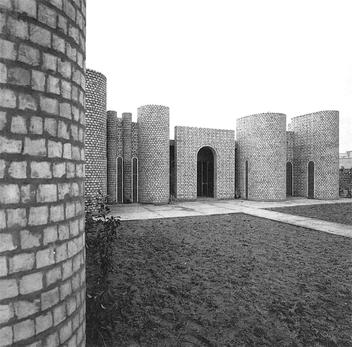
Rifat Chadirji, Yasoub Rafiq Residence, Baghdad, 1965. Image courtesy of Rifat Chadirji.
This presentation will examine the critical encounters that took place in mid-twentieth-century Baghdad between native architects and some of Modernism's most renowned figures who were brought to the city as part of country’s oil-fueled development campaign. Specifically, the buildings of Rifat Chadirji will be compared with Walter Gropius's proposal for the new campus of the University of Baghdad, as the two struggled to give shape to the ambitions of a newly independent Iraq. By reading both against the crisis of historicism declared by contemporaneous architectural historians, Alsaden will demonstrate how working in Baghdad created tensions that forced a radical shift in architectural practice.
Amin Alsaden is a PhD candidate at Harvard University whose work focuses on global exchanges of ideas and expertise across cultural boundaries. His research interests include modern architecture, especially in the Muslim and Arab worlds; questions of globalism and universalism in architectural history and design; governance and space in conflict zones; formal and cognitive attributes of interiors; sociopolitical and professional motives behind cultural institutions and districts; and monumentality in contemporary art and architecture. His dissertation investigates a crucible moment in post-WWII Baghdad, when a host of factors produced an unprecedented architectural movement characterized by a unique intellectual agenda and aesthetic, later exported to a modernizing Middle East; it aims to demonstrate the social role architecture played in a crisis-laden Baghdad, and how the creative class embraced a cosmopolitan ethos manifested in their output. Alsaden holds an MA from Harvard University, a post-professional MArch from Princeton University, and a BArch with a minor in interior design from the American University of Sharjah. He practiced at various firms in Europe and the Middle East, most recently at OMA and MVRDV in the Netherlands.
The Graham would like to thank Perrier for supporting our public programs.
For more information on the exhibition, Every Building in Baghdad: The Rifat Chadirji Archives at the Arab Image Foundation, click here.

In this presentation, Nora Akawi aims to situate today’s experience of Jerusalem, a city trapped in constant excavation, in relation to its interrupted modernization in the past, and the obstructed imaginaries for a future. Through a brief overview of different forms of digging in the city (for archaeological excavations, for foundations of large construction, but also the systematic plowing through inhabited homes and neighborhoods), Akawi will feature Palestinian urban resilience in the city in the face of the violent destruction of traces of the past and the obstruction of possibilities to plan for a future.
Nora Akawi is an architect based between Amman and New York. In 2012, she joined Columbia University’s Graduate School of Architecture, Planning and Preservation (GSAPP) as curator of Studio-X Amman, a regional platform for programming and research in architecture run by Columbia GSAPP and the Columbia Global Centers | Amman. At Studio-X Amman, she leads the conceptualization and implementation of public programs and research initiatives on architecture in the Arab Mashreq by curating conferences, workshops, publications, screenings, lectures, and other collective forms of production in partnership with researchers or institutions in the region. Since 2014, she has been teaching a graduate seminar course of theory and visualization focused on borderlands, migration, citizenship and human rights at GSAPP. She studied architecture at the Bezalel Academy of Art and Design in Jerusalem (B.Arch 2009). In 2011, she received her MS in Critical, Curatorial and Conceptual Practices in Architecture from Columbia GSAPP (MS.CCCP 2011), where she received the CCCP Thesis Award. Her thesis investigates the role of the archive in the formation of alternative political and spatial imaginaries in Palestine. She participates as Visiting Lecturer at Stockholm's Royal Institute of Art, in the Critical Habitats post-graduate program, and has served as critic in architecture programs at Columbia GSAPP, Barnard College, PennDesign, Harvard GSD, Georgia Tech, the Applied Science University in Amman, and GJU's SABE, among others. Publications include the book Architecture and Representation: The Arab City (co-edited by Amale Andraos, Nora Akawi, and Caitlin Blanchfield, Columbia Books on Architecture and the City, 2016), and "Jerusalem: Dismantling Phantasmagorias, Constructing Imaginaries" in The Funambulist: Militarized Cities (edited by L. Lambert, 2015).
Image: Road #4, photo by Omar Abdelqader
The Graham would like to thank Perrier for supporting our public programs.
For more information on the exhibition, Every Building in Baghdad: The Rifat Chadirji Archives at the Arab Image Foundation, click here.
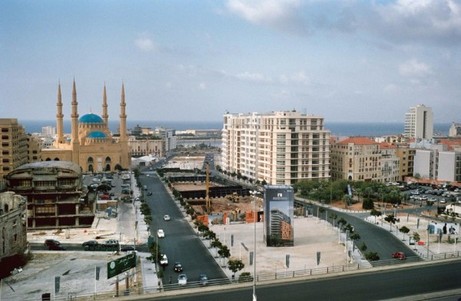
Beirut, Martyr’s Square, during recent redevelopment. Photo: Solidere.
Amale Andraos will discuss her recent publication, The Arab City: Architecture and Representation co-edited with Nora Akawi, which engages contemporary architectural and urban production in the Middle East. Taking the "Arab City" and "Islamic Architecture" as sites of investigation rather than given categories, this book reframes the region's buildings, cities, and landscapes and broadens its architectural and urban canons.
Amale Andraos is Dean of Columbia University’s Graduate School of Architecture, Planning and Preservation (GSAPP) and co-founder of WORKac, a New York-based architectural and urban practice focused on re-imaging architecture at the intersection of the urban, the rural, and the natural. The practice has achieved international recognition for projects such as the Centre de Conferences in Libreville, Gabon and the Edible Schoolyard at PS216 in Brooklyn, NY. Her current projects include the Miami Collage Garage and a residential conversion of a historic New York cast-iron building. WORKac was named the AIA New York State Firm of the Year in 2015. Prior to Columbia, Andraos taught at universities including Princeton University School of Architecture, Harvard Graduate School of Design, and the American University in Beirut. Her publications include Architecture and Representation: The Arab City, co-edited with Nora Akawi, as well as 49 Cities and Above the Pavement the Farm! co-authored with her partner, Dan Wood.
The Graham would like to thank Perrier for supporting our public programs.
For more information on the exhibition, Every Building in Baghdad: The Rifat Chadirji Archives at the Arab Image Foundation, click here.
Unless otherwise noted,
all events take place at:
Madlener House4 West Burton Place, Chicago
The Graham Foundation galleries are currently closed to the public.
The bookshop is open by appointment only:
Wed–Fri, 12–5 p.m.
To make an appointment, email: [email protected]
CONTACT
312.787.4071
[email protected]
Accessibility
Events are held in the ballroom on the third floor which is only accessible by stairs.The first floor of the Madlener House is accessible via an outdoor lift. Please call 312.787.4071 to make arrangements.
Copyright © 2008–2025 Graham Foundation. All rights reserved.